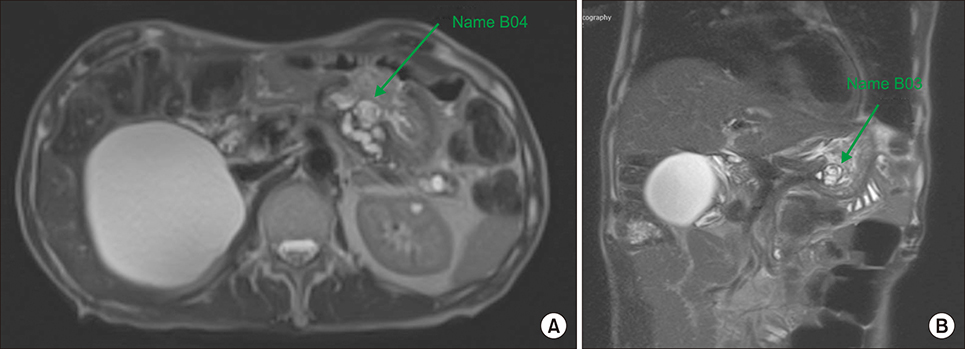Ann Hepatobiliary Pancreat Surg.
2019 May;23(2):206-209. 10.14701/ahbps.2019.23.2.206.
Robotic assisted laparoscopic completion pancreatectomy for recurrent intraductal papillary mucinous neoplasm after previous open pancreatoduodenectomy: A case report and literature review
- Affiliations
-
- 1Department of Hepatopancreatobiliary and Transplant Surgery, Singapore General Hospital, Singapore. bsgkp@hotmail.com
- 2Duke-NUS Medical School, Singapore.
- KMID: 2448779
- DOI: http://doi.org/10.14701/ahbps.2019.23.2.206
Abstract
- Completion pancreatectomy (CP), is an effective, and potentially curative option for selected patients with local recurrence of pancreatic neoplasms in the remnant pancreas after initial pancreatoduodenectomy (PD). Traditionally CP has been performed via the open approach. Reports of minimally-invasive CP particularly after previous open PD are rare. We present a case of a 72-year old male who previously underwent open PD 5 years ago for intraductal papillary mucinous neoplasm (IPMN) with high grade dysplasia in the uncinate process. He had multifocal IPMN and low-risk lesions in the body and tail were managed conservatively. On routine surveillance, the cyst in the body was noted to be increasing in size with the development of a non-enhancing solid component confirmed on magnetic resonance imaging and subsequent endoscopic ultrasonography. The patient underwent successful robotic assisted laparoscopic completion pancreatectomy. Final histology confirmed a recurrent IPMN with low-to-intermediate grade dysplasia. The postoperative recovery was uneventful and he was discharged on postoperative day 9.
Keyword
MeSH Terms
Figure
Reference
-
1. Bressan AK, Wahba M, Dixon E, Ball CG. Completion pancreatectomy in the acute management of pancreatic fistula after pancreaticoduodenectomy: a systematic review and qualitative synthesis of the literature. HPB (Oxford). 2018; 20:20–27.
Article2. Sahakyan MA, Yaqub S, Kazaryan AM, Villanger O, Berstad AE, Labori KJ, et al. Laparoscopic completion pancreatectomy for local recurrence in the pancreatic remnant after pancreaticoduodenectomy: case reports and review of the literature. J Gastrointest Cancer. 2016; 47:509–513.
Article3. Kleeff J, Reiser C, Hinz U, Bachmann J, Debus J, Jaeger D, et al. Surgery for recurrent pancreatic ductal adenocarcinoma. Ann Surg. 2007; 245:566–572.
Article4. Miura F, Takada T, Amano H, Yoshida M, Isaka T, Toyota N, et al. Repeated pancreatectomy after pancreatoduodenectomy. J Gastrointest Surg. 2007; 11:179–186.
Article5. Goh BKP, Low TY, Lee SY, Chan CY, Chung AYF, Ooi LLPJ. Initial experience with robotic pancreatic surgery in Singapore: single institution experience with 30 consecutive cases. ANZ J Surg. 2019; 89:206–210.
Article6. Goh BKP, Lee SY, Kam JH, Soh HL, Cheow PC, Chow PKH, et al. Evolution of minimally invasive distal pancreatectomies at a single institution. J Minim Access Surg. 2018; 14:140–145.
Article7. Caba Molina D, Lambreton F, Arrangoiz Majul R. Trends in robotic pancreaticoduodenectomy and distal pancreatectomy. J Laparoendosc Adv Surg Tech A. 2019; 29:147–151.
Article8. Joechle K, Conrad C. Cost-effectiveness of minimally invasive pancreatic resection. J Hepatobiliary Pancreat Sci. 2018; 25:291–298.
Article9. Palanivelu C, Senthilnathan P, Sabnis SC, Babu NS, Srivatsan Gurumurthy S, Anand Vijai N, et al. Randomized clinical trial of laparoscopic versus open pancreatoduodenectomy for periampullary tumours. Br J Surg. 2017; 104:1443–1450.
Article10. Poves I, Burdío F, Morató O, Iglesias M, Radosevic A, Ilzarbe L, et al. Comparison of perioperative outcomes between laparoscopic and open approach for pancreatoduodenectomy: the PADULAP randomized controlled trial. Ann Surg. 2018; 268:731–739.11. Koizumi M, Sata N, Kasahara N, Morishima K, Sasanuma H, Sakuma Y, et al. Remnant pancreatectomy for recurrent or metachronous pancreatic carcinoma detected by FDG-PET: two case reports. JOP. 2010; 11:36–40.12. Strobel O, Hartwig W, Hackert T, Hinz U, Berens V, Grenacher L, et al. Re-resection for isolated local recurrence of pancreatic cancer is feasible, safe, and associated with encouraging survival. Ann Surg Oncol. 2013; 20:964–972.
Article13. Miyazaki M, Yoshitomi H, Shimizu H, Ohtsuka M, Yoshidome H, Furukawa K, et al. Repeat pancreatectomy for pancreatic ductal cancer recurrence in the remnant pancreas after initial pancreatectomy: is it worthwhile? Surgery. 2014; 155:58–66.
Article14. Guerra F, Giuliani G, Bencini L, Bianchi PP, Coratti A. Minimally invasive versus open pancreatic enucleation. Systematic review and meta-analysis of surgical outcomes. J Surg Oncol. 2018; 117:1509–1516.
Article15. Sunagawa H, Mayama Y, Orokawa T, Oshiro N. Laparoscopic total remnant pancreatectomy after laparoscopic pancreaticoduodenectomy. Asian J Endosc Surg. 2014; 7:71–74.
Article
- Full Text Links
- Actions
-
Cited
- CITED
-
- Close
- Share
- Similar articles
-
- Current status of robotic surgery for pancreatic tumors
- ArtiSential-assisted laparoscopic central pancreatectomy
- Intraductal Papillary Mucinous Tumor Simultaneously Involving the Liver and Pancreas: A Case Report
- Oncocytic Type Intraductal Papillary Mucinous Neoplasm Mimicking Mucinous Cystic Neoplasm of the Pancreas: A Case Report
- Comparison of Mucinous Cystic Tumor and Intraductal Papillary Mucinous Tumor


